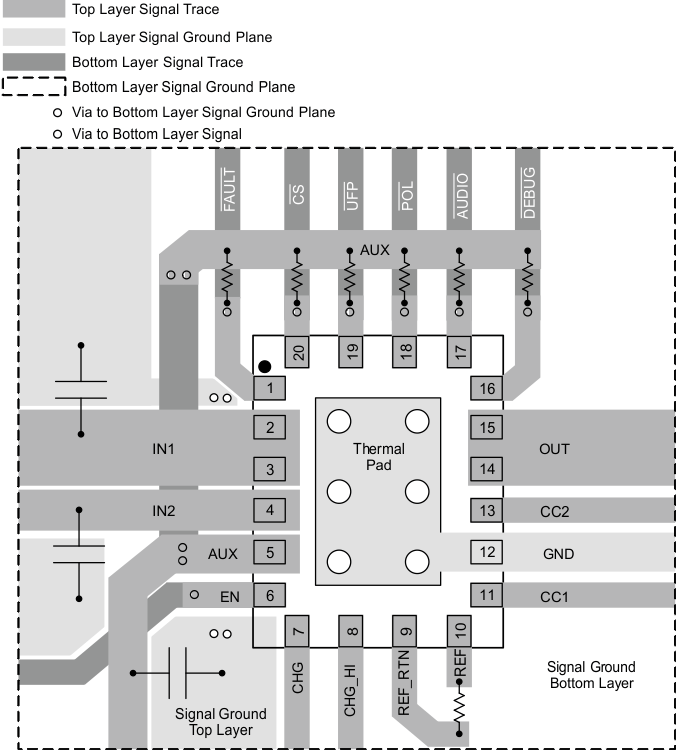ZHCSGW8 April 2017 TPS25810A-Q1
PRODUCTION DATA.
- 1 特性
- 2 应用
- 3 说明
- 4 修订历史记录
- 5 说明 (续)
- 6 Pin Configuration and Functions
- 7 Specifications
- 8 Detailed Description
- 9 Application and Implementation
- 10Power Supply Recommendations
- 11Layout
- 12器件和文档支持
- 13机械、封装和可订购信息
11 Layout
11.1 Layout Guidelines
Layout best practices as they apply to the TPS25810A-Q1 device are listed as follows.
- For all applications, a 10-µF ceramic capacitor is recommended near the Type-C receptacle and another 120‑µF ceramic capacitor close to the IN1 pin.
- The optimum placement of the 120-µF capacitor is closest to the IN1 and GND pins of the device.
- Care must be taken to minimize the loop area formed by the bypass capacitor connection, the IN1 pin, and the GND pin of the device. See Figure 28 for a PCB layout example.
- High-current-carrying power-path connections to the device should be as short as possible and should be sized to carry at least twice the full-load current.
- Have the input and output traces as short as possible. The most common cause of voltage loss failure in USB power delivery is the resistance associated with the VBUS trace. Trace length, maximum current being supplied for normal operation, and total resistance associated with the VBUS trace must be taken into account while budgeting for voltage loss.
- For example, a power-carrying trace that supplies 3 A, at a distance of 20 inches, 0.1-in. wide, with 2‑oz. copper on the outer layer has a total resistance of approximately 0.046 Ω and voltage loss of 0.14 V. The same trace at 0.05 in. wide has a total resistance of approximately 0.09 Ω and voltage loss of 0.28 V.
- Make power traces as wide as possible.
- The resistor attached to the REF pin of the device has several requirements:
- It is recommended to use a 1% 100-kΩ low-temperature-coefficient resistor.
- It should be connected to the REF and REF_RTN pins (pins 9 and pin 10, respectively).
- The REF_RTN pin should be isolated from the GND plane. See Figure 28.
- The trace routing between the REF and REF_RTN pins of the device should be as short as possible to reduce parasitic effects on current-limit and current-advertisement accuracy. These traces should not have any coupling to switching signals on the board.
- Locate all TPS25810A-Q1 pullup resistors for open-drain outputs close to their connection pin. Pullup resistors should be 100 kΩ.
- When a particular open-drain output is not used or needed in the system, leave the associated pin open or tied to GND.
- Keep the CC lines close to the same length.
- Thermal considerations:
- When properly mounted, the thermal-pad package provides significantly greater cooling ability than an ordinary package. To operate at rated power, the thermal pad must be soldered to the board GND plane directly under the device. The thermal pad is at GND potential and can be connected using multiple vias to inner-layer GND. Other planes, such as the bottom side of the circuit board, can be used to increase heat sinking in higher-current applications. See PowerPad™ Thermally Enhanced Package and PowerPAD™ Made Easy for more information on using this thermal pad package.
- Obtaining acceptable performance with alternate layout schemes is possible; however, the layout example in the following section has been shown to produce good results and is intended as a guideline.
- ESD considerations:
- The TPS25810A-Q1 device has built-in ESD protection for CC1 and CC2. Keep trace length to a minimum from the Type-C receptacle to the TPS25810A-Q1 device on CC1 and CC2.
- A 10-µF output capacitor should be placed near the Type-C receptacle.
- See the TPS25810EVM-745 evaluation module for an example of a double-layer board that passes IEC61000-4-2 testing.
- Do not create stubs or test points on the CC lines. Keep the traces short if possible, and use minimal vias along the traces [1–2 inches (2.54 cm–5.08 cm) or less].
- See ESD Protection Layout Guide for additional information.
- Have a dedicated ground plane layer, if possible, to avoid differential voltage buildup.
11.2 Layout Example
 Figure 28. Layout Example
Figure 28. Layout Example